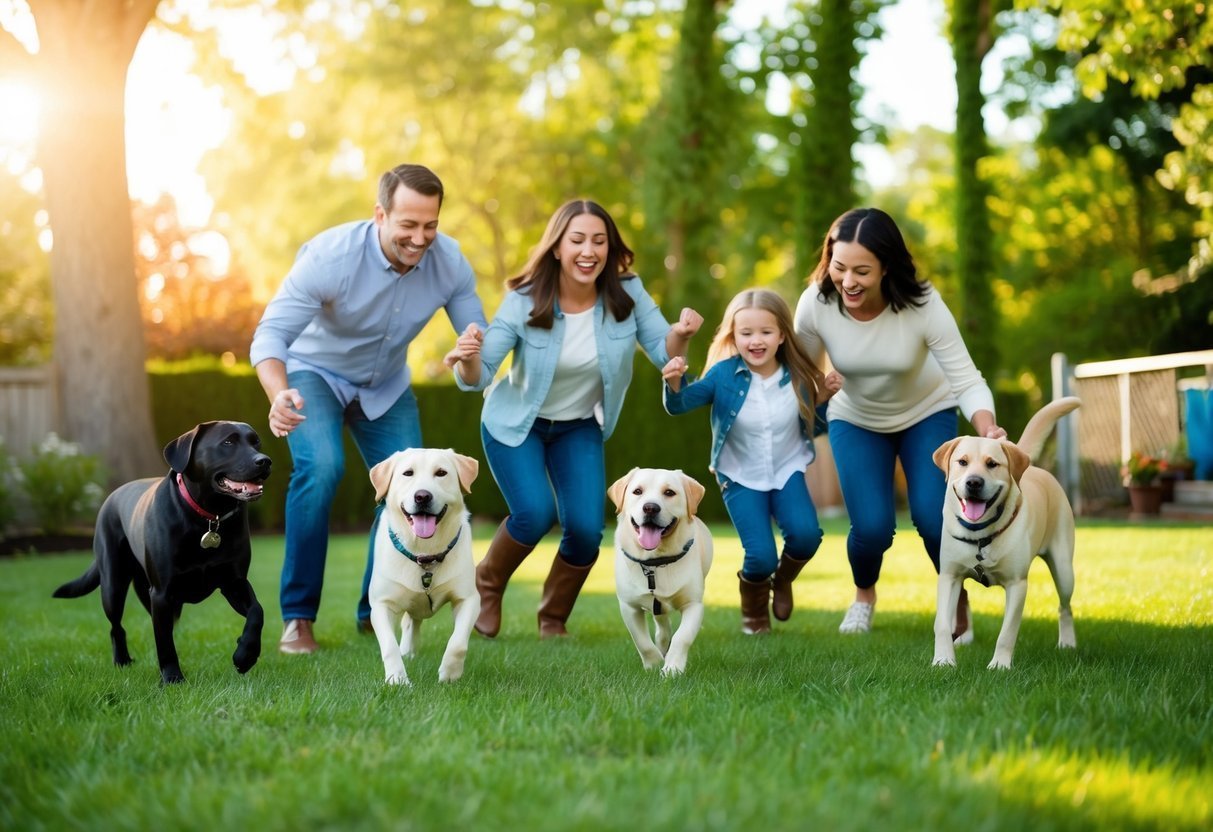When it comes to family pets, finding the right dog can make all the difference.
Lab mixes are known for their friendly nature and easygoing personality, making them great companions for families.
Many Lab mix combinations offer a blend of traits that can enhance their suitability as loving family dogs.
In this article, you’ll discover four popular Lab mix combinations that stand out for their friendly temperament and playful energy.
These dogs not only bond well with kids but also adapt easily to different lifestyles.
You’ll learn why these mixes are often considered the best choices for a family environment.
1) Labrador Retriever-Poodle (Labradoodle)
The Labradoodle is a popular mix between a Labrador Retriever and a Poodle.
This combination gives you a friendly and intelligent dog.
Labradoodles are great companions for families.
These dogs are known for their playful and affectionate nature.
They typically get along well with children and other pets.
Their energy levels make them fun playmates.
Another benefit is their coat.
Labradoodles often have a low-shedding coat, which can be better for people with allergies.
This trait comes from the Poodle side of the family.
Training a Labradoodle is usually easy.
They are smart and eager to please, which makes them quick learners.
You’ll enjoy teaching them new tricks and commands.
Whether you need a running buddy or a couch companion, a Labradoodle can fit the bill.
They thrive on attention and love to be included in family activities.
This mix can bring a lot of joy to your home.
2) Labrador Retriever-Golden Retriever (Goldador)
The Goldador is a delightful mix of the Labrador Retriever and the Golden Retriever.
This combination brings together the best traits of both breeds, making them fantastic family pets.
You’ll find that Goldadors are friendly and affectionate.
They get along well with children and other animals, which makes them great companions for family life.
These dogs usually weigh between 60 and 80 pounds.
They have a muscular build and a soft, water-resistant coat that may be golden or light tan.
Regular grooming helps keep their coat healthy.
Goldadors are intelligent and easy to train.
Their eagerness to please means they often excel in obedience training and can learn commands quickly.
If you’re looking for a loyal, loving family dog, the Goldador fits the bill.
They enjoy spending time with their families and require regular exercise to stay happy and healthy.
Whether playing fetch or going for a walk, your Goldador will love being active with you.
They thrive on companionship and will bring a lot of joy to your home.
3) Labrador Retriever-Border Collie (Borador)

The Labrador Retriever-Border Collie mix, often called the Borador, is a lively and affectionate breed.
This mix brings together the friendly nature of Labs and the intelligence of Border Collies.
Boradors are great for active families.
They love to play, exercise, and be part of all family activities.
Daily walks and playtime are essential to keep them happy and healthy.
These dogs are also eager to please, making training easier.
You’ll find that they pick up commands quickly.
Whether it’s fetching a ball or learning new tricks, they thrive on interaction.
Socialization is key for Boradors.
Early exposure to different people and environments helps them grow into well-rounded pets.
They usually get along well with kids and other animals.
Their coats can vary, but regular grooming is a good idea.
This helps reduce shedding and keeps their fur in good condition.
If you’re looking for a loving and active companion, the Borador might be a perfect fit.
They’ll bring joy and energy to your home while forming a strong bond with your family.
For more details, check out this guide on the Border Collie Lab mix.
4) Labrador Retriever-Beagle (Beagador)

The Beagador is a fun mix of the Labrador Retriever and the Beagle.
This blend gives you a friendly and energetic dog that loves being around people.
Beagadors usually inherit the playful nature of both parents.
This means they are great for families with kids.
They enjoy playtime and love to be active, so your family can have plenty of fun together.
These dogs are also known to be smart.
Their intelligence makes them easy to train with positive reinforcement.
They want to please you, which makes training sessions enjoyable.
In terms of size, Beagadors are usually medium-sized dogs.
They often have the sturdy build of Labradors and the compact look of Beagles.
This mix typically lives between 10 to 15 years, which is a good lifespan for a dog.
Because they have mixed genes, Beagadors can be healthier than purebreds.
This means you’re likely to have a lively companion for many years.
If you want a loving and energetic family dog, the Beagador could be an excellent choice for you.
Understanding Lab Mixes

Lab mixes are popular choices for families due to their friendly nature and versatility.
By combining the traits of the Labrador Retriever with other breeds, these dogs can offer a range of personalities and temperaments suitable for family life.
Why Choose a Lab Mix?
Choosing a Lab mix can bring the best of both worlds to your home.
Labradors are known for their friendly and outgoing demeanor.
When mixed with other breeds, they often inherit desirable traits from each parent.
Some popular combinations include:
- Labradoodle: Friendly and hypoallergenic coat.
- Boxador (Boxer-Lab mix): Energetic and playful.
- Frenchie Lab: A blend of ease and playfulness.
These mixes typically adapt well to family life and are great with children, making them an excellent choice for a companion.
General Temperament and Characteristics
Lab mixes often display a mix of traits that make them ideal family pets.
They are generally good-natured, intelligent, and eager to please.
Common characteristics include:
- Sociable: They get along well with kids and other pets.
- Energetic: They enjoy playtime and regular exercise.
- Trainable: Most Lab mixes are quick learners because of their Labrador heritage.
Remember, while most Lab mixes have these traits, their temperament can vary based on the other breed in the mix.
Training and socialization are key to helping them thrive in a family setting.
Training and Socialization

Training and socialization are key parts of raising a happy and well-adjusted Lab mix.
With the right approach, your dog can become a loving family member and fit into your home life.
Focus on positive reinforcement and early experiences for the best results.
Basic Training Tips
Start training your Lab mix as early as possible.
Begin with basic commands like “sit,” “stay,” and “come.” Use treats and praise to reward your dog when they follow commands.
This helps build a strong bond between you.
Establish a consistent routine.
Dogs thrive on predictability.
Make training sessions short and fun.
Aim for 5-10 minutes several times a day to keep your dog engaged.
Address unwanted behaviors promptly.
If your dog barks excessively or jumps on guests, correct them with gentle reminders.
Clear boundaries help your dog understand what is acceptable.
Socialization with Family and Pets
Socializing your Lab mix is crucial for their happiness and well-being.
Introduce them to various people, pets, and environments while they are young.
Start at home by letting them interact with family members and friends.
Take your dog to different places like parks or pet-friendly stores.
This exposure helps them become more confident and less fearful of new experiences.
Use positive reinforcement when your Lab mix meets new pets.
Monitor their interactions to ensure they remain friendly and calm.
Early socialization leads to better behavior around children and other animals, creating a more harmonious home.
Frequently Asked Questions

When considering a Labrador mix, it’s important to know about their traits, size, and other care factors.
Here are some common questions that can help you choose the right Lab mix for your family.
What are some common traits of Labrador mix breeds as family pets?
Labrador mixes are known for their friendly and social nature.
They often inherit the fun-loving attitude of Labradors, making them great companions.
Many Lab mixes are also loyal, eager to please, and adaptable to different family situations.
How do different Labrador mixes compare in size?
The size of a Lab mix can vary widely depending on the other breed in the mix.
For example, a Labradoodle can be anywhere from small to medium, while a Goldador often has a size similar to a full Labrador.
Always check the parent breeds to get a better idea of the expected size.
What should you consider when looking for lab mix puppies for sale?
When looking for Lab mix puppies, consider their background, health history, and temperament.
Always choose a reputable breeder or rescue to ensure a healthy puppy.
Meeting the puppy’s parents can also give you insights into their potential behavior and traits.
Are Labrador Retriever mixes generally good with children?
Yes, most Labrador mixes are known to be good with children.
They often inherit the gentle and playful nature of Labradors, making them patient and friendly playmates.
Always supervise interactions, especially with younger children, to ensure safe play.
What are the exercise needs for a Lab mix?
Lab mixes generally require regular exercise to stay healthy and happy.
Daily walks, playtime, and mental stimulation are crucial.
Some mixes, especially those with more active parent breeds, may need extra playtime to burn off energy.
How do you train and socialize a Labrador mix puppy?
Start training and socialization early with a Lab mix puppy.
Use positive reinforcement techniques to encourage good behavior.
Socializing them with different people, pets, and environments helps them grow into well-rounded adults.
Consistent training will make your Lab mix a joyful family member.

